

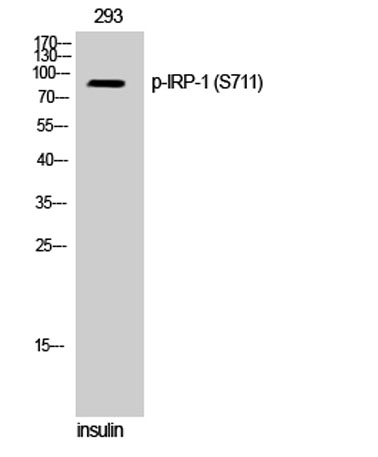
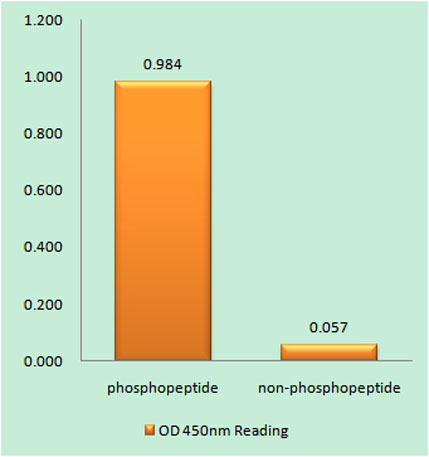
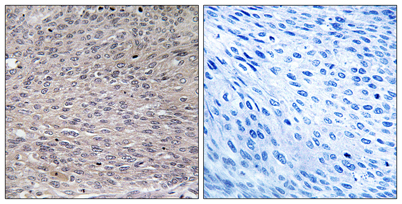
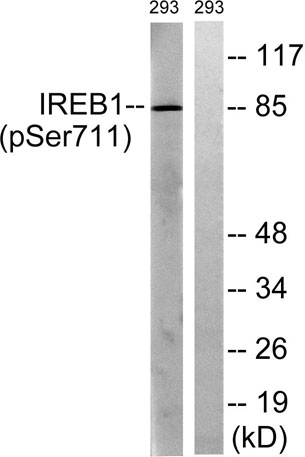
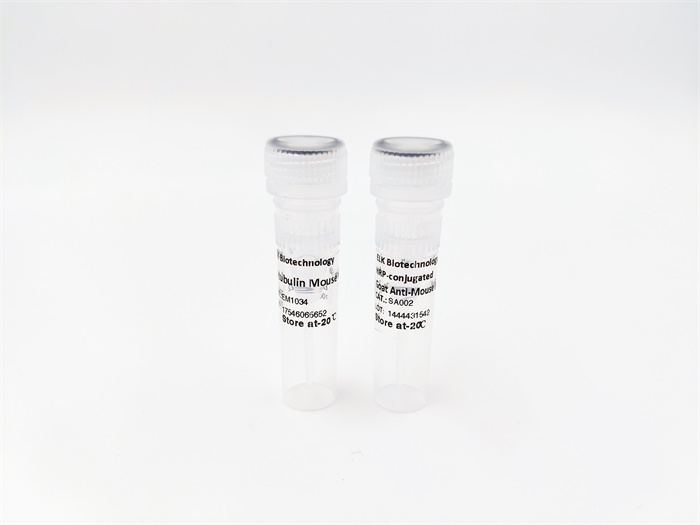



IRP-1 (phospho Ser711) rabbit pAb
 One-click to copy product information
One-click to copy product information$148.00/50µL $248.00/100µL
| 50 µL | $148.00 |
| 100 µL | $248.00 |
Overview
| Product name: | IRP-1 (phospho Ser711) rabbit pAb |
| Reactivity: | Human;Mouse;Rat;Monkey |
| Alternative Names: | ACO1; IREB1; Cytoplasmic aconitate hydratase; Aconitase; Citrate hydro-lyase; Ferritin repressor protein; Iron regulatory protein 1; IRP1; Iron-responsive element-binding protein 1; IRE-BP 1 |
| Source: | Rabbit |
| Dilutions: | Western Blot: 1/500 - 1/2000. Immunohistochemistry: 1/100 - 1/300. ELISA: 1/10000. Not yet tested in other applications. |
| Immunogen: | The antiserum was produced against synthesized peptide derived from human IREB1 around the phosphorylation site of Ser711. AA range:681-730 |
| Storage: | -20°C/1 year |
| Clonality: | Polyclonal |
| Isotype: | IgG |
| Concentration: | 1 mg/ml |
| Observed Band: | 85kD |
| GeneID: | 48 |
| Human Swiss-Prot No: | P21399 |
| Cellular localization: | Cytoplasm, cytosol . |
| Background: | The protein encoded by this gene is a bifunctional, cytosolic protein that functions as an essential enzyme in the TCA cycle and interacts with mRNA to control the levels of iron inside cells. When cellular iron levels are high, this protein binds to a 4Fe-4S cluster and functions as an aconitase. Aconitases are iron-sulfur proteins that function to catalyze the conversion of citrate to isocitrate. When cellular iron levels are low, the protein binds to iron-responsive elements (IREs), which are stem-loop structures found in the 5' UTR of ferritin mRNA, and in the 3' UTR of transferrin receptor mRNA. When the protein binds to IRE, it results in repression of translation of ferritin mRNA, and inhibition of degradation of the otherwise rapidly degraded transferrin receptor mRNA. The encoded protein has been identified as a moonlighting protein based on its ability to perform mechanistically distinct |
-
 Western Blot analysis of 293 cells using Phospho-IRP-1 (S711) Polyclonal Antibody
Western Blot analysis of 293 cells using Phospho-IRP-1 (S711) Polyclonal Antibody -
 Enzyme-Linked Immunosorbent Assay (Phospho-ELISA) for Immunogen Phosphopeptide (Phospho-left) and Non-Phosphopeptide (Phospho-right), using IREB1 (Phospho-Ser711) Antibody
Enzyme-Linked Immunosorbent Assay (Phospho-ELISA) for Immunogen Phosphopeptide (Phospho-left) and Non-Phosphopeptide (Phospho-right), using IREB1 (Phospho-Ser711) Antibody -
 Immunohistochemistry analysis of paraffin-embedded human thyroid gland, using IREB1 (Phospho-Ser711) Antibody. The picture on the right is blocked with the phospho peptide.
Immunohistochemistry analysis of paraffin-embedded human thyroid gland, using IREB1 (Phospho-Ser711) Antibody. The picture on the right is blocked with the phospho peptide. -
 Western blot analysis of lysates from 293 cells treated with insulin 0.01U/ml 30', using IREB1 (Phospho-Ser711) Antibody. The lane on the right is blocked with the phospho peptide.
Western blot analysis of lysates from 293 cells treated with insulin 0.01U/ml 30', using IREB1 (Phospho-Ser711) Antibody. The lane on the right is blocked with the phospho peptide.

 Manual
Manual